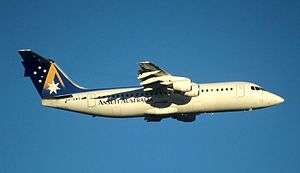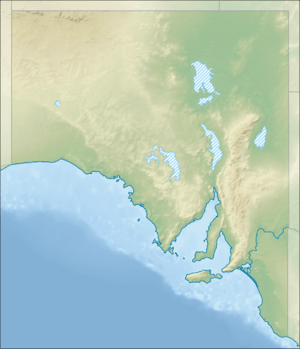RAAF Base Woomera
| RAAF Base Woomera | |||||||||
|---|---|---|---|---|---|---|---|---|---|
| RAAF Woomera Airfield | |||||||||
| Part of RAAF Woomera Range Complex | |||||||||
| Near Woomera, South Australia in Australia | |||||||||
 Ansett Australia BAe 146, flying above RAAF Base Woomera in 1998 | |||||||||
 RAAF Base Woomera YPWR Location of the base in South Australia | |||||||||
| Coordinates | 31°08′39″S 136°49′01″E / 31.14417°S 136.81694°ECoordinates: 31°08′39″S 136°49′01″E / 31.14417°S 136.81694°E | ||||||||
| Type | Military air base | ||||||||
| Site information | |||||||||
| Owner | Department of Defence | ||||||||
| Operator |
| ||||||||
| Website | RAAF Base Woomera | ||||||||
| Site history | |||||||||
| Built | 1947 | ||||||||
| In use |
1 January 2015 – present (as RAAF Base Woomera) | ||||||||
| Airfield information | |||||||||
| Identifiers | IATA: UMR, ICAO: YPWR | ||||||||
| Elevation | 167 metres (548 ft) AMSL | ||||||||
| |||||||||
| Sources: Australian AIP and aerodrome chart[1] | |||||||||
RAAF Base Woomera, or RAAF Woomera Airfield (IATA: UMR, ICAO: YPWR), is an operational Royal Australian Air Force (RAAF) military airbase located within the 122,188-square-kilometre (47,177 sq mi) RAAF Woomera Range Complex, situated approximately 3 nautical miles (5.6 km; 3.5 mi) north[1] of the Woomera Village, in South Australia, Australia. Officially established as an airbase with effect from January 2015, the RAAF Base Woomera comprises the Woomera airfield, hangars and technical areas as well as the Woomera Village.[2][3] Operational management of the airbase (and its satellite airfield "Evetts Field") is under the command and control of Headquarters, Woomera Test Range (which is located approximately 450 km (280 mi) south-east of Woomera, at RAAF Base Edinburgh near Adelaide). The base is an integral part of the aerospace test and evaluation role the RAAF Woomera Range Complex (WRC) provides for the defence of Australia. There are full-time operational staff at the Woomera Village who support airfield operations, and access to the field is controlled through the WTR headquarters in Adelaide.
Normally, civilian aircraft are not given permission to use the airfield unless such use is related to Defence activities at Woomera.
RAAF Woomera is able to operate all current types of aircraft used by the Australian Defence Forces (ADF), including C-17 Globemasters and all fast-jet types. The airfield can be fitted with an arrestor cable system when required to bring it to normal RAAF operating standards for FA-18 Hornet operations. The airfield is also well able to handle larger aircraft types such as the C-5 Galaxy and Boeing 747. Large aircraft movements occur often at Woomera in support of ADF test and evaluation activities on the complex.
Historical
The centre line of the airfield was surveyed by Len Beadell in early 1947.[4] A RAF Dakota was the first aircraft to use the field, as it landed at Woomera on 19 June 1947. It brought General Evetts and a party of British scientists to inspect the airfield which was recently completed.[4]:101
The control tower at RAAF Base Woomera originally came from RAAF Base Uranquinty, New South Wales. The tower was disassembled by No. 2 Airfield Construction Squadron in the late 1940s and shipped to Woomera where it was re-erected and reopened in the early 1950s. It is still active at RAAF Woomera and is likely to remain so for many years to come. In 2016 the Department of Defence announced plans to replace the control cabin and an upgrade to all communications, electrical, mechanical and hydraulic services to the building in order to comply with building code requirements.[5]
Evetts Field
Evetts Field (AU09)[6] is a satellite airfield located 40 kilometres (25 mi) north-west of the RAAF Base Woomera within the RAAF Woomera Range Complex. On 15 May 1951 Koolymilka airfield was officially named Evetts Field in honour of Lieutenant General John Fullerton Evetts, who led the English party that selected the Woomera site for the Anglo-Australian Long Range Weapons Establishment, and handed over to the Department of Supply.[7] Evetts Field is now only semi operational, mostly used as an emergency runway for the Flying Doctor and for RAAF operations. It features two runways, each 2,028 metres (6,654 ft) long. Evetts Field was used for launching the Jindivik target drone from 31 October 1950 to June 1975.[8] The airfield was virtually abandoned in the 1970s, with its control tower and other buildings sold off and removed. The two runways are now in poor condition.
See also
References
- 1 2 YPWR – Woomera (PDF). AIP En Route Supplement from Airservices Australia, effective 01 March 2018, Aeronautical Chart Archived 11 April 2012 at the Wayback Machine.
- ↑ "RAAF Base Woomera lifts off" (Press release). department of Defence. 5 November 2014. Retrieved 25 August 2017.
- ↑ "New Year will be a new start for Woomera base". InterconnectSystems. 2014. Retrieved 25 August 2017.
- 1 2 Beadell, Len (1975). Still in the Bush. Adelaide: Rigby Limited. ISBN 0-7270-0020-9.
- ↑ "Air 5431 Facilities Project". Defence Infrastructure Division. department of Defence. 2016. Retrieved 25 August 2017.
- ↑ "Airport Nav Finder: Evetts Field". Retrieved 28 February 2014.
- ↑ "2ACS WOOMERA". Retrieved 26 February 2014.
- ↑ "Jindivik". Defence Science and Technology Organisation. Department of Defence, Australian Government. Retrieved 23 September 2015.
External links
- RAAF Base Woomera at www.airforce.gov.au
- RAAF Base Woomera museum
- "Blast from the Past". Adelaide Adertiser. 25 July 2009. Archived from the original on 3 September 2009.
- "Woomera Range Remediation Facilities Project: Statement of Evidence to the Parliamentary Committee on Public Works". Department of Defence. Canberra: Parliament of Australia. 2016.